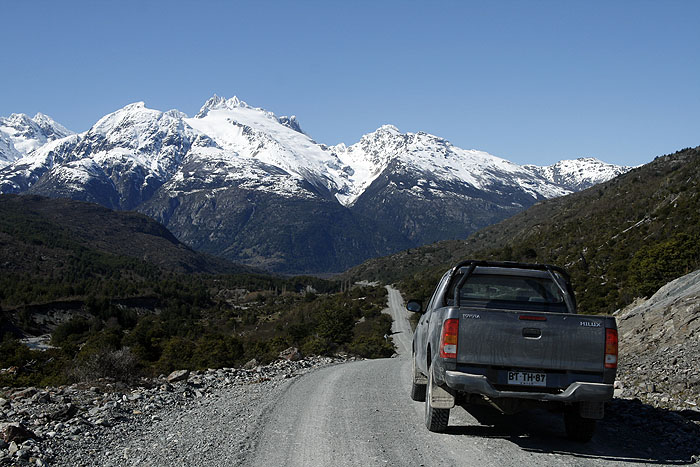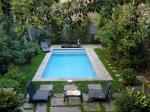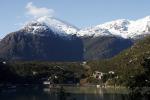The last time I visited Chile was a brief foray to the north of the country and the Atacama desert. I had been completely captivated by the surreal landscapes of the area, so when I was offered the chance to see some of Chile's southern highlights and try a self-drive itinerary on a stretch of road known as the last adventure road in the world, I jumped at the opportunity.
My trip began in Santiago, a mix of modern skyscrapers with a snow-capped mountain backdrop. International flight connections mean that you will almost certainly need a night in the capital, either at the start or end of a trip. The city has a real energy, particularly in the lively neighbourhoods of Bellavista and Lastarria with its shops and street entertainers, chic bars and restaurants, and some fine boutique hotels such as The Aubrey and Lastarria.
From Santiago I flew south to Coyhaique, a small town in northern Patagonia and the starting point for my self-drive trip along the southern Carretera Austral. A 1,200km stretch of unpaved road cutting through jagged Andean peaks, native forests and shimmering lakes, the Carretera Austral is still relatively undiscovered. Hiring a vehicle is the best way to explore the region and any qualms I had beforehand soon disappeared when I was handed my driving instructions and maps. I had a 4x4 pickup for four days, and only had time to explore a small section of the highway. Accommodation along the road is simple but homely, and the views from the various lodges are spectacular. I spent the first night at Mirador de Guadal on the shores of Lago General Carrera, the largest lake in the area and home to some beautiful marble caves. Like many of the lodges along the road, they take good care of their guests - no sooner had I parked the car, Stefan (the owner) was handing me a freshly-made Pisco sour, delicious!
The following day I continued south to the stilt village of Caleta Tortel, where there are no roads, only wooden walkways (cars are left in a car park at the town entrance). Here we like Entre Hielos lodge where a bed, after a long day's driving, would have been very welcome. Sadly, my tight schedule meant that I had to head back north, staying the night at Green Baker Lodge. The lodge is built on the banks of the Rio Baker, Chile's largest river and home to a healthy population of brown and rainbow trout. It is a real adventure lodge - by no means just for fishermen - and perfect for families, with riding, rafting, and kayaking all offered.
A handful of nature reserves are dotted along the road, and on my final full day I decided to take a detour and visit the Patagonia National Park, where I was met by a group of inquisitive guanacos. After a couple of hours taking photos, I carried on north to the village of Puerto Rio Tranquillo, where I filled up the car (always a good idea to fill up when you see a pump - you don't know how long it will be until you see another!) and spent the night at the comfortable and quaint El Puesto. The drive back to Balmaceda airport on the final morning gave me chance to reflect on the past three days. If you want high speed internet, gourmet restaurants and nightlife until the early hours, the Carretera Austral probably wouldn't be what you're looking for. But, if you have a sense of adventure, aren't fazed by a wild horse in the road and want to get off the beaten track it may be just what you are looking for.
My next destination was the town of Puerto Varas, on the shores of Lake Llanquihue in Chile's southern Lake District and another region that can easily be explored with a hire car. The town's horizon is dominated by the wonderful snow-capped peak of Osorno volcano, which, on a clear day, is one of the highlights of the famous lake crossing into Argentina. South of Puerto Varas is the Alerce Andino forest, and a short boat road away is the mythical island of Chiloé. This whole region has a strong German heritage, which is seen in many of the buildings, including Estancia 440, once a homestead and now a pretty B&B. Outside of town there are larger and more traditional Chilean guesthouses, including Los Caiquenes, which overlooks the lake and is a perfect place to relax and unwind.
My time in Chile came to an end in the far south of the country, in the magnificent Torres del Paine National Park, a Mecca for walkers and nature lovers. The park is a five hour drive north from Punta Arenas (where most visitors arrive) and there is a variety of accommodation inside and outside the park. I particularly liked the slightly bizarre but beautiful Mongolian styled yurts at Patagonia Camp, and the far more traditional Cerro Guido, a working estancia where guests can experience life as a huaso (a Chilean cowboy). Hiring a car is one way to explore the area, but many of the lodges now offer all-inclusive packages, including transfers, excursions and all meals.
After two nights in the park I left and headed south to the town of Puerto Natales, a welcome stop, breaking up the long journey back to Punta Arenas airport. Natales itself is relatively small with a handful of shops and hotels, which look out across the haunting Ultima Esperanza 'Last Hope' sound. Glancing out across the water it is impossible for your eye not to be drawn to the large, industrial-looking building on the further shore, now The Singular hotel. A meat storage plant during the nineteenth-century, the building has been converted into one of Latin America's most luxurious and unique hotels. Throughout the building the original machinery from its meat storage days is still on show. The bedrooms are beautifully decorated, with antique furniture and huge panoramic windows looking out across the sound. Days can be spent relaxing in the spa or on an excursion, I chose the latter as I wanted to walk off some of the delicious food served in the restaurant. It was a spectacular way to end my trip.
My return to Chile certainly didn't disappoint. The self-drive portion was a real adventure and would be ideal for anyone wanting to get off the beaten track. The natural beauty of the Lake District was the perfect place to relax and no visit to Chile would be complete without a visit to Torres del Paine, known by many as the 'Eighth Wonder of the World'.








